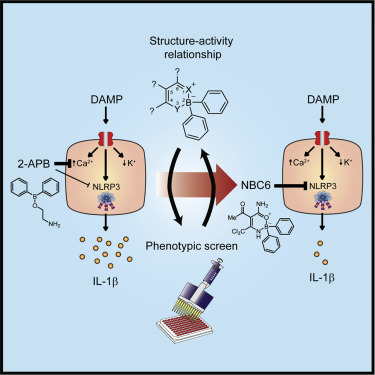当前位置:
X-MOL 学术
›
Cell Chem. Bio.
›
论文详情
Our official English website, www.x-mol.net, welcomes your
feedback! (Note: you will need to create a separate account there.)
Boron-Based Inhibitors of the NLRP3 Inflammasome
Cell Chemical Biology ( IF 6.6 ) Pub Date : 2017-09-21 00:00:00 , DOI: 10.1016/j.chembiol.2017.08.011 Alex G. Baldwin , Jack Rivers-Auty , Michael J.D. Daniels , Claire S. White , Carl H. Schwalbe , Tom Schilling , Halah Hammadi , Panichakorn Jaiyong , Nicholas G. Spencer , Hazel England , Nadia M. Luheshi , Manikandan Kadirvel , Catherine B. Lawrence , Nancy J. Rothwell , Michael K. Harte , Richard A. Bryce , Stuart M. Allan , Claudia Eder , Sally Freeman , David Brough
Cell Chemical Biology ( IF 6.6 ) Pub Date : 2017-09-21 00:00:00 , DOI: 10.1016/j.chembiol.2017.08.011 Alex G. Baldwin , Jack Rivers-Auty , Michael J.D. Daniels , Claire S. White , Carl H. Schwalbe , Tom Schilling , Halah Hammadi , Panichakorn Jaiyong , Nicholas G. Spencer , Hazel England , Nadia M. Luheshi , Manikandan Kadirvel , Catherine B. Lawrence , Nancy J. Rothwell , Michael K. Harte , Richard A. Bryce , Stuart M. Allan , Claudia Eder , Sally Freeman , David Brough

|
NLRP3 is a receptor important for host responses to infection, yet is also known to contribute to devastating diseases such as Alzheimer's disease, diabetes, atherosclerosis, and others, making inhibitors for NLRP3 sought after. One of the inhibitors currently in use is 2-aminoethoxy diphenylborinate (2APB). Unfortunately, in addition to inhibiting NLRP3, 2APB also displays non-selective effects on cellular Ca2+homeostasis. Here, we use 2APB as a chemical scaffold to build a series of inhibitors, the NBC series, which inhibit the NLRP3 inflammasomein vitroandin vivowithout affecting Ca2+homeostasis. The core chemical insight of this work is that the oxazaborine ring is a critical feature of the NBC series, and the main biological insight the use of NBC inhibitors led to was that NLRP3 inflammasome activation was independent of Ca2+. The NBC compounds represent useful tools to dissect NLRP3 function, and may lead to oxazaborine ring-containing therapeutics.
中文翻译:

NLRP3炎性小体的基于硼的抑制剂
NLRP3是对于宿主对感染的反应重要的受体,但也已知其促成破坏性疾病,例如阿尔茨海默氏病,糖尿病,动脉粥样硬化等,这使得NLRP3的抑制剂受到追捧。当前使用的抑制剂之一是2-氨基乙氧基二苯基硼酸酯(2APB)。不幸的是,除了抑制NLRP3,2APB还对细胞的Ca2 +稳态表现出非选择性作用。在这里,我们使用2APB作为化学支架来构建一系列抑制剂NBC系列,该抑制剂在体外和体内抑制NLRP3炎性体而不影响Ca2 +稳态。这项工作的核心化学见解是恶唑aborine环是NBC系列的关键特征,使用NBC抑制剂导致的主要生物学见解是NLRP3炎性体活化独立于Ca2 +。
更新日期:2017-11-19
中文翻译:

NLRP3炎性小体的基于硼的抑制剂
NLRP3是对于宿主对感染的反应重要的受体,但也已知其促成破坏性疾病,例如阿尔茨海默氏病,糖尿病,动脉粥样硬化等,这使得NLRP3的抑制剂受到追捧。当前使用的抑制剂之一是2-氨基乙氧基二苯基硼酸酯(2APB)。不幸的是,除了抑制NLRP3,2APB还对细胞的Ca2 +稳态表现出非选择性作用。在这里,我们使用2APB作为化学支架来构建一系列抑制剂NBC系列,该抑制剂在体外和体内抑制NLRP3炎性体而不影响Ca2 +稳态。这项工作的核心化学见解是恶唑aborine环是NBC系列的关键特征,使用NBC抑制剂导致的主要生物学见解是NLRP3炎性体活化独立于Ca2 +。











































 京公网安备 11010802027423号
京公网安备 11010802027423号